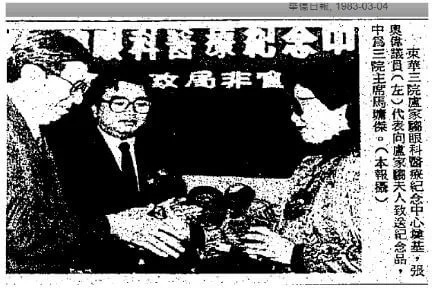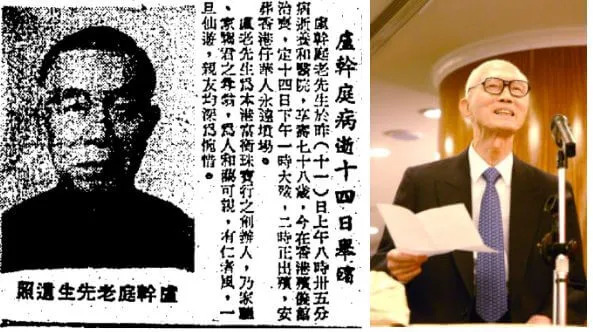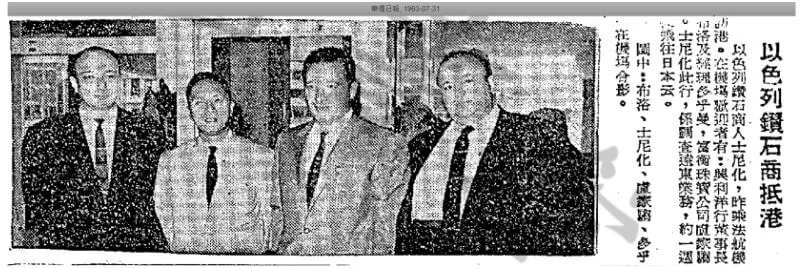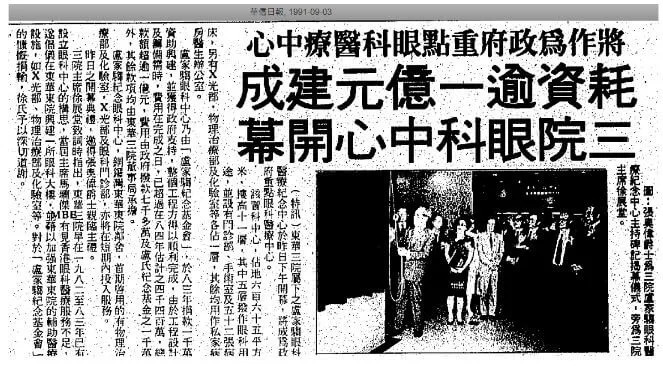Foo Hang, Tai Hang, Lee Heng and B. Green – Four Leaders of the HK Diamonds Industry
(Source: The Industrial History of Hong Kong Group)

Left: Lo Fong Siu-po of Foo Hang (right) receiving a souvenir for her generous donations to establish the Lo Ka-chow Memorial Opthalmic from Sir Oswald Cheung while Max Ma of Lee Heng (center) as chairman of Tung Wah looked on. (WKYP, 1983-3-4)
Earlier on the website, we covered Casey Liu, who was known as the “King of Diamonds” as the only sight holder for De Beers in the Far East at one time and started the region’s first diamond cutting factory. Foo Hang Jewellery, Tai Hang Jewellery, Lee Heng Diamond and B. Green are four major players in the diamond industry in Hong Kong which emerged after the War in the 1940s and helped to popularize diamonds in Hong Kong. Before then, diamonds were primarily sold to Westerners in HK and the Chinese population generally preferred gold and jade and the diamond trade was also dominated by merchants of foreign descent such as the Ipekdjian family and the Gregory family (to be covered). As diamonds became a passport for survival during the Japanese occupation given its ease to hide, the Chinese population became interested in diamonds and when the Communists came to power in the mainland in 1949, many Shanghainese brought diamonds with them to HK where they were able to sell them and then used the capital to establish various textile and other factories. The influx of Shanghainese refugees provided another boost to the local diamond business.
With Hong Kong’s status as a duty-free port and diamond imports was restricted in most Asian countries after the War, the diamond business in HK took off in the 1950s and 1960s as merchants from throughout Southeast Asia came to HK to source diamonds. (Taiwan also became an important market for HK diamond traders after it was ousted from the United Nations in 1971) To establish and set the standards for the industry, to have more bargaining power negotiating with foreign authorities, the traders formed the Diamond Importers Association (DIA) in 1959. In the 1970s, the local jewelry manufacturing industry emerged in HK which provided another boost to the industry and as local retail sales also took off thanks to increasingly affluent local residents, the DIA introduced its DIA Decal which jewelry stores could display and also the “Introduction Card Kit” to tourists and local residents to enhance consumer confidence and protection. In the more recent decades, the introduction of diamond certification, the lifting of trade barriers and the emergence of the Internet has disrupted the traditional business model of the diamond importers and wholesalers and forced them to shift more into manufacturing and retail. According to HKTDC, HK exported US$15.2 billion worth of loose polished and non-industrial diamonds in 2016.
Today Foo Hang and Lee Heng are still actively involved in the running of the trade organization Diamond Federation of HK (DFHK, founded in 2000) – formerly the DIA and the HK Diamond Bourse (HKDB, founded in 1985).
The Lo Families and Foo Hang Jewellery(富衡珠寶)

Left: Obituary of Lo Kon-ting (KSDN, 1970-5-12); Right: Lo Ka-chung at the 60th anniversary celebration of Foo Hang in 2004 (Foo Hang’s website)
Foo Hang was founded in 1944 by Lo Kon-ting (盧幹庭), a native of HuMen, DongGuan. The family was involved in peddling of canned food and groceries and other miscellaneous goods during the Japanese occupation. Mr. Lo Kon Ting’s wife was a broker in jewellery business having connections with several local jewellery stores. Being able to obtain jewellery items from these stores on consignment, she would visit her private clients’ home to present these jewellery collection to ladies who traditionally would not leave home to go around town shopping for valuable ornaments. With her connections, she introduced her two sons Lo Ka Chung (盧家驄, 1923-) and Lo Ka Chow (盧家騶 1926-1976) into the trade during Japanese occupation period. In 1944 Foo Hang Jewellery was formally registered as a private entity in a 10 square meter office on roof top of King’s Theater (present Entertainment Building). Later the firm moved to Hing Wai Building when King’s Theater was redeveloped into a 17storeys office building, the Entertainment Building in 1960’s, and Foo Hang subsequently moved back to 16th floor of this new building.
Foo Hang joined the HK General Chamber of Commerce which was then dominated by British merchants in 1947 to get access to important information about the international diamond trade. In 1948, Lo Ka Chung took a 60 hours flight from Hong Kong to Tel Aviv to become the first Hong Kong citizen landed on Israeli soil (holding the Israeli Visa 001) and the first company to import diamonds polished in the new independent state of Israel. Thanks to the efforts of the brothers who established ties with Israel and South Africa, Foo Hang quickly emerged as one of the leading importers of diamonds in Hong Kong. In 1959, together with several diamond traders, Lo Ka Chung initiated the formation of Diamond Importers Association to set a standard in business practices in diamond trade as well as raising the bargaining power of traders on negotiation of terms with local and foreign authorities. The low-key Lo family has been active with the group and its successor DFHK since its inception (Lo Ka-chung’s son Ken is currently vice chairman of DFHK).

Lo Ka-chow (second from left) and George Bloch (first from left) and Dorfman welcome Israeli diamond tycoon Moshe Schnitzer (second from right) in 1963 (WKYP, 1963-7-31)
In the 1960s, the Lo family was involved in the development of Melbourne Plaza in Central where Foo Hang has operated since the 1980’s on the 18th floor until 2021 when they moved to 7/F, 8 Russell Street, Causeway Bay.

Article and picture of the opening ceremony of the Lo Ka Chow Memorial Ophthalmic Centre in 1991 (WKYP, 1991-9-3)
As the wholesale business evolved, Lo Ka-Chung with the assistance his sons Ken Lo Chung-fai (盧仲輝) and Lo Pak-Shiu (盧伯韶) and his nephews expanded into manufacturing and retail with the establishment of Jewellery Flair Ltd in 1979, Eternity Diamond & Jewellery (永生珠寶) in 1981 and Eternity Manufacturing (永生製造廠) in 1986.
Outside of business, the family has been active in philanthropy. During the War, Lo Ka-Chow gave away half of his fortune in the form of ten taels of gold to feed the starving Jesuit priests at his alma mater Wah Yan College. He wanted to become a doctor but had to forego further education to support his family at a young age.
The Lo’s Family established its own charitable foundation in founding and supporting educational institutions and medical research activities. These include the Tung Wah Group of Hospitals Lo Kon Ting Memorial College in memory of their father, Mr. Lo Kon Ting; the Lo Ka Chung Centre for Natural Anti-Cancer Drugs Development at the Hong Kong Polytechnic University and the Lo Ka Chung University Centre at the Hong Kong University of Science and Technology.